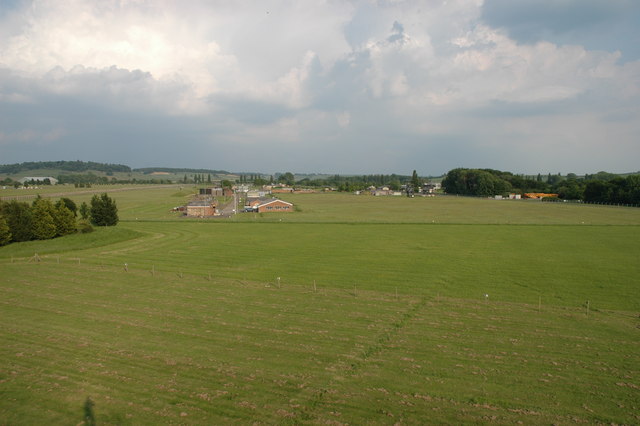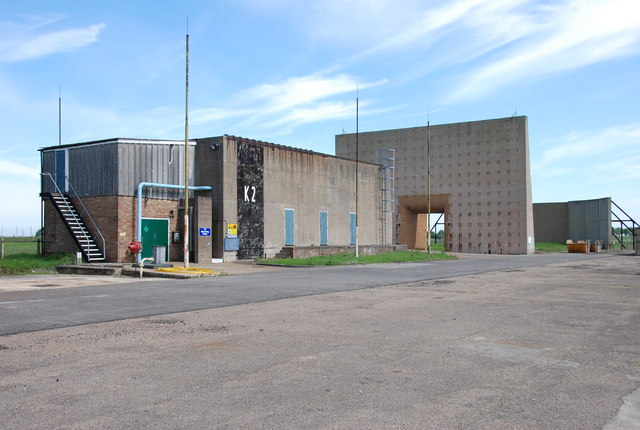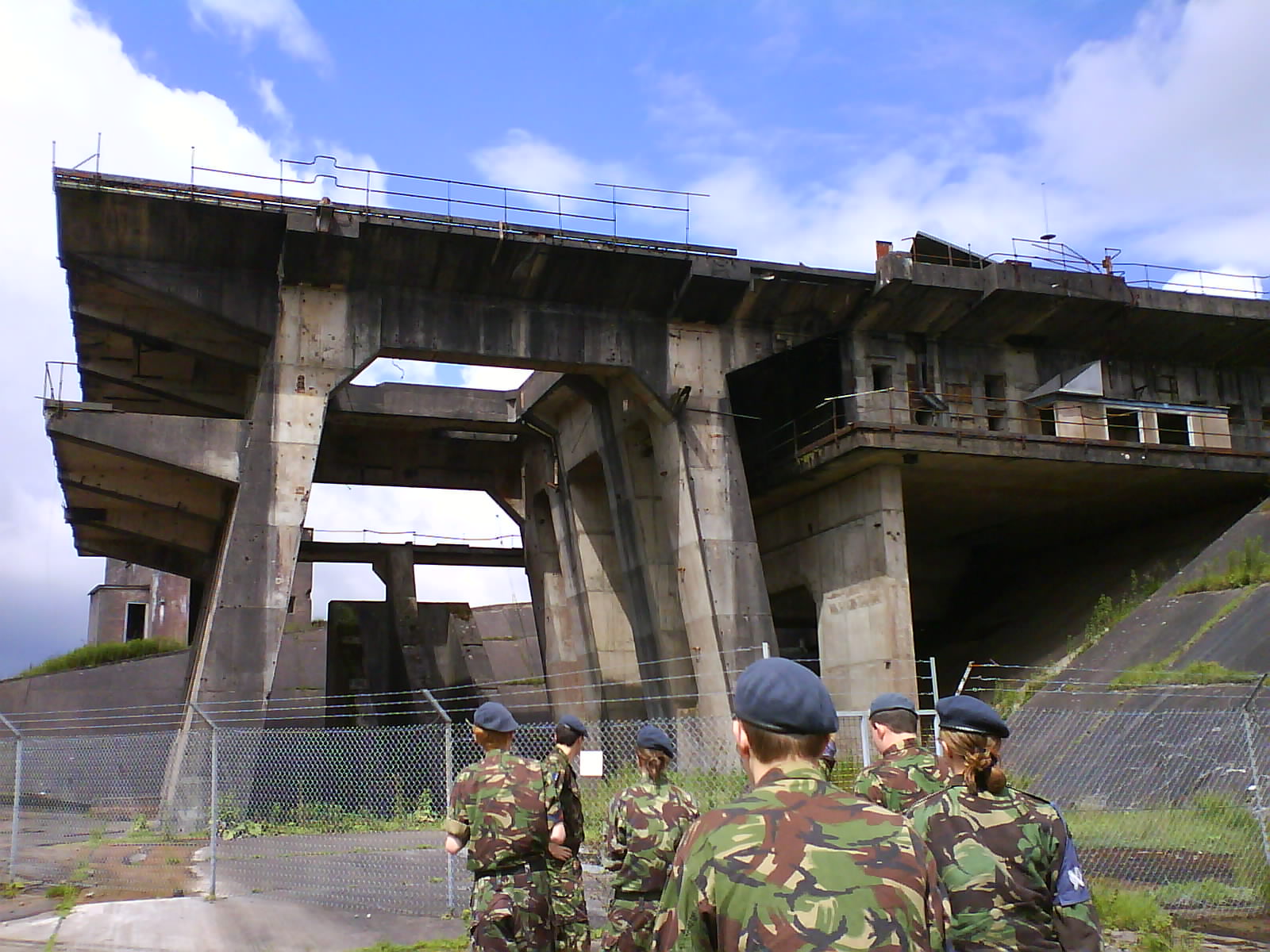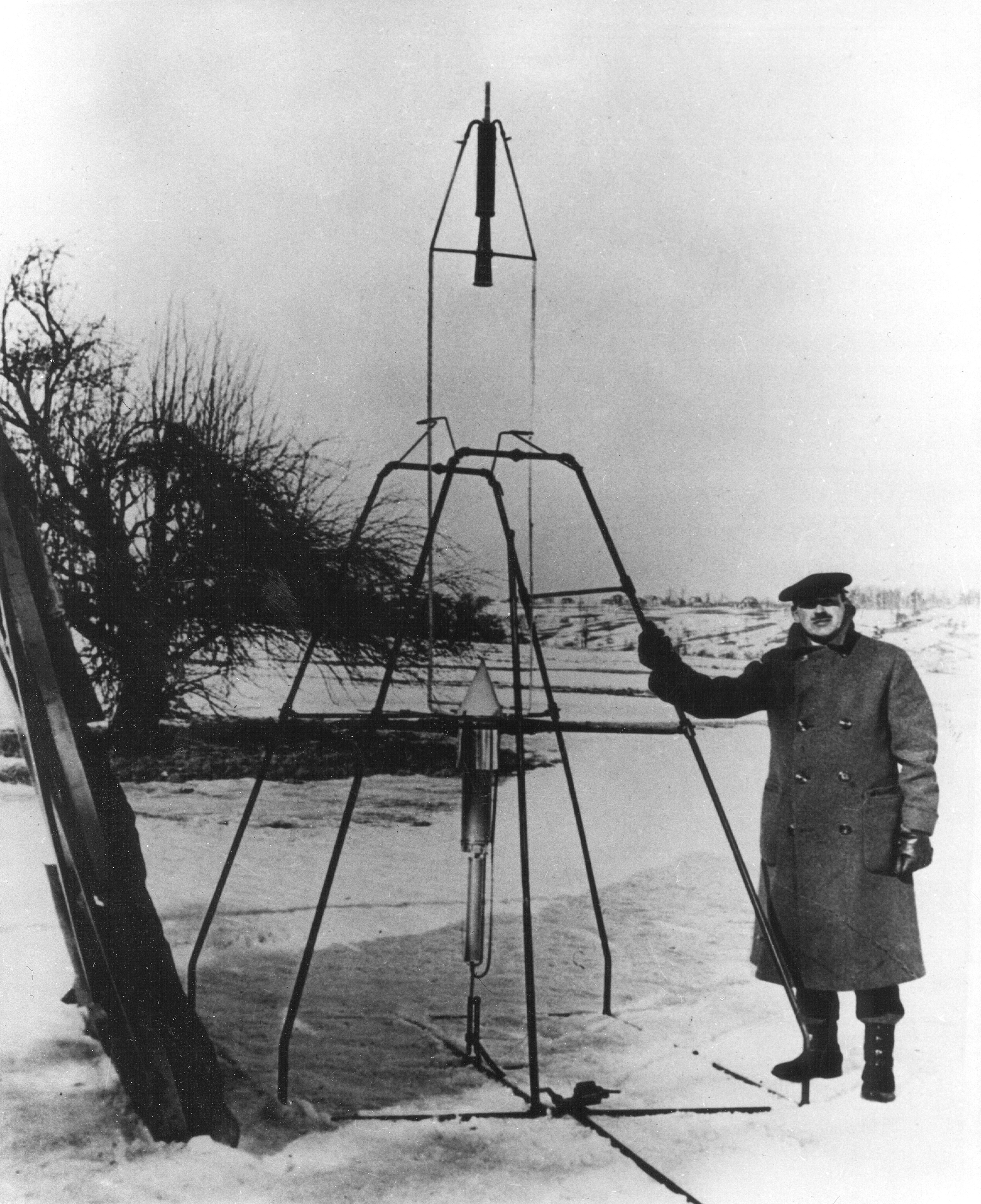|
Westcott Venture Park
RAF Westcott is a former Royal Air Force station located near Westcott in Buckinghamshire, England. The site fully opened in September 1942 and was the base of No.11 Operational Training Unit (OTU) flying the Vickers Wellington medium bomber until the RAF moved out in August 1945, the station was officially closed on 3 April 1946. The airfield was then transferred to the Ministry of Supply and became the home for the Rocket Propulsion Establishment until the mid-1990s. The site is now Westcott Venture Park, which is the registered address for 37 companies. History Second World War RAF Westcott opened in September 1942 along with its satellite station RAF Oakley. The airfield was equipped with 3 concrete runways. Shortly after its opening, No. 11 Operational Training Unit (OTU) moved in from RAF Bassingbourn operating the Vickers Wellington bomber. The OTU played a major part in the training of bomber crews during the Second World War, as part of this training, tra ... [...More Info...] [...Related Items...] OR: [Wikipedia] [Google] [Baidu] |
Rocket Propulsion Establishment
The Rocket Propulsion Establishment at Westcott, Buckinghamshire on the site of the former RAF Westcott has made a number of notable contributions in the field of rocket propulsion, including input on the rocket design for the Blue Streak missile and the propulsion systems on Chevaline. It was also known as the Guided Projectiles Establishment and PERME Westcott (Propellants, Explosives and Rocket Motor Establishment, Westcott). For many years this establishment was regarded as so secret that it was not marked on Ordnance Survey maps, although it was present, from necessity, on maps for the use of pilots. History The establishment was set up in April 1946 under the Ministry of Supply. In the initial years a team of German scientists worked at the site, and examples of German weapons were on-site for study. These included the V-1 flying bomb; V-2; Feuerlilie F-55 subsonic missile; Messerschmitt Me 163B rocket-propelled interceptor; Rheintochter-1 anti-aircraft missile; Ruhr ... [...More Info...] [...Related Items...] OR: [Wikipedia] [Google] [Baidu] |
Westcott, Buckinghamshire
Westcott is a village and civil parishes in England, civil parish in the unitary authority area of Buckinghamshire, England, about west of Waddesdon. The Toponymy, toponym is derived from the Old English for "west cottage". The Church of England parish church of Veneration of Mary in Roman Catholicism, St Mary the Virgin was designed by the Diocese of Oxford, Oxford Diocesan architect George Edmund Street, G.E. Street and built in 1867. It is a Listed building#Categories of listed building, Grade II* listed building. In the 20th century Westcott was the site of the Rocket Propulsion Establishment, which was on the former RAF Westcott airfield to the west of the main village. This has since been closed down, and the area is called the Westcott Venture Park. BAE Systems maintains a presence on the site (BAE Systems Environmental) which advises on the decommissioning of military sites. G.E. Street also designed the parish school. It is now Westcott Church of England School, a mi ... [...More Info...] [...Related Items...] OR: [Wikipedia] [Google] [Baidu] |
Air Navigation
The basic principles of air navigation are identical to general navigation, which includes the process of planning, recording, and controlling the movement of a craft from one place to another. Successful air navigation involves piloting an aircraft from place to place without getting lost, not breaking the laws applying to aircraft, or endangering the safety of those on board or on the ground. Air navigation differs from the navigation of surface craft in several ways; aircraft travel at relatively high speeds, leaving less time to calculate their position en route. Aircraft normally cannot stop in mid-air to ascertain their position at leisure. Aircraft are safety-limited by the amount of fuel they can carry; a surface vehicle can usually get lost, run out of fuel, then simply await rescue. There is no in-flight rescue for most aircraft. Additionally, collisions with obstructions are usually fatal. Therefore, constant awareness of position is critical for aircraft pilots. The ... [...More Info...] [...Related Items...] OR: [Wikipedia] [Google] [Baidu] |
LEROS
Leros (), also called Lero (from the Italian language), is a Greek island and municipality in the Dodecanese in the southern Aegean Sea. It lies from Athens's port of Piraeus, from which it can be reached by a nine-hour ferry ride or by a 45-minute flight from Athens. It is about from Turkey. Leros is part of the Kalymnos regional unit. It has a population of 7,992 (2021). Geography The municipality has an area of . The municipality includes the populated offshore island of Farmakonisi (pop. 21), as well as several uninhabited islets, including Levitha and Kinaros, and had a 2021 census population of 7,992, although this figure swells to over 15,000 during the summer peak. The island has a coastline of . It is known for its imposing medieval castle of the Knights of Saint John possibly built on a Byzantine fortress. Nearby islands are Patmos, Lipsi, Kalymnos, and the small islands of Agia Kyriaki and Farmakos. In ancient times it was considered the island of Parthenos ... [...More Info...] [...Related Items...] OR: [Wikipedia] [Google] [Baidu] |
Ordnance Survey
The Ordnance Survey (OS) is the national mapping agency for Great Britain. The agency's name indicates its original military purpose (see Artillery, ordnance and surveying), which was to map Scotland in the wake of the Jacobite rising of 1745. There was also a more general and nationwide need in light of the potential threat of invasion during the Napoleonic Wars. Since 1 April 2015, the Ordnance Survey has operated as Ordnance Survey Ltd, a state-owned enterprise, government-owned company, 100% in public ownership. The Ordnance Survey Board remains accountable to the Secretary of State for Science, Innovation and Technology. It was also a member of the Public Data Group. Paper maps represent only 5% of the company's annual revenue. It produces digital map data, online route planning and sharing services and mobile apps, plus many other location-based products for business, government and consumers. Ordnance Survey mapping is usually classified as either "Scale (map), lar ... [...More Info...] [...Related Items...] OR: [Wikipedia] [Google] [Baidu] |
Europa (rocket)
The Europa rocket was an early expendable launch system of the European Launcher Development Organisation (ELDO), which was the precursor to the European Space Agency (ESA). It was developed with the aim to delivering space access technology, and more specifically to facilitate the deployment of European-wide telecommunication and meteorological satellites into orbit. The program ultimately traces its history to the British Blue Streak (missile), Blue Streak missile, which was cancelled in 1960. Blue Streak was then used as the basis of the Black Prince (rocket), Black Prince expendable launch system and several other concepts. Looking for partners to share development costs, ELDO was formed and began development of the Europa using the Blue Streak first stage along with the French-built Coralie second stage and German Astris upper stage. The programme proceeded to perform multiple test launches but these frequently resulted in partial failures. In addition, Britain decided to ... [...More Info...] [...Related Items...] OR: [Wikipedia] [Google] [Baidu] |
Blue Streak (missile)
The de Havilland Propellers Blue Streak was a British Intermediate-range ballistic missile (IRBM), and later the first stage of the Europa satellite launch vehicle. Blue Streak was cancelled without entering full production. The project was intended to maintain an independent British nuclear deterrent, replacing the V bomber fleet which would become obsolete by 1965. The operational requirement for the missile was issued in 1955 and the design was complete by 1957. During development, it became clear that the missile system was too expensive and too vulnerable to a surprise attack. The missile project was cancelled in 1960, with US-led Skybolt the preferred replacement. Partly to avoid political embarrassment from the cancellation, the UK government proposed that the rocket be used as the first stage of a civilian satellite launcher called Black Prince. As the cost was thought to be too great for the UK alone, international collaboration was sought. This led to the formati ... [...More Info...] [...Related Items...] OR: [Wikipedia] [Google] [Baidu] |
Liquid Rocket Propellant
The highest specific impulse chemical rockets use liquid propellants (liquid-propellant rockets). They can consist of a single chemical (a monopropellant) or a mix of two chemicals, called bipropellants. Bipropellants can further be divided into two categories; hypergolic propellants, which ignite when the fuel and oxidizer make contact, and non-hypergolic propellants which require an ignition source. About 170 different propellants made of liquid fuel have been tested, excluding minor changes to a specific propellant such as propellant additives, corrosion inhibitors, or stabilizers. In the U.S. alone at least 25 different propellant combinations have been flown. Many factors go into choosing a propellant for a liquid-propellant rocket engine. The primary factors include ease of operation, cost, hazards/environment and performance. History Development in early 20th century Konstantin Tsiolkovsky proposed the use of liquid propellants in 1903, in his article ''Exploration ... [...More Info...] [...Related Items...] OR: [Wikipedia] [Google] [Baidu] |
V-2 Rocket
The V2 (), with the technical name ''Aggregat (rocket family), Aggregat-4'' (A4), was the world's first long-range missile guidance, guided ballistic missile. The missile, powered by a liquid-propellant rocket engine, was developed during the Second World War in Nazi Germany as a "V-weapons, vengeance weapon" and assigned to attack Allies of World War II, Allied cities as retaliation for the Strategic bombing during World War II#The British later in the war, Allied bombings of German cities. The rocket also became the first artificial object to travel into space by crossing the Kármán line (edge of space) with the vertical launch of MW 18014 on 20 June 1944. Research of military use of long-range rockets began when the graduate studies of Wernher von Braun were noticed by the German Army. A series of prototypes culminated in the A4, which went to war as the . Beginning in September 1944, more than 3,000 were launched by the Wehrmacht against Allied targets, first London and ... [...More Info...] [...Related Items...] OR: [Wikipedia] [Google] [Baidu] |
V-1 Flying Bomb
The V-1 flying bomb ( "Vengeance Weapon 1") was an early cruise missile. Its official Reich Aviation Ministry () name was Fieseler Fi 103 and its suggestive name was (hellhound). It was also known to the Allies as the buzz bomb or doodlebug and (maybug). The V-1 was the first of the (V-weapons) deployed for the terror bombing of London. It was developed at Peenemünde Army Research Center in 1939 by the at the beginning of the Second World War, and during initial development was known by the codename "Cherry Stone". Due to its limited range, the thousands of V-1 missiles launched into England were fired from V-1 flying bomb facilities, launch sites along the French (Pas-de-Calais) and Dutch coasts or by modified Heinkel He 111 aircraft. The Wehrmacht first launched the V-1s against London on 13 June 1944, one week after (and prompted by) Operation Overlord, the Allied landings in France. At times more than one hundred V-1s a day were fired at south-east England, 9,521 in t ... [...More Info...] [...Related Items...] OR: [Wikipedia] [Google] [Baidu] |
List Of RAF Regiment Units
This is a list of units of the Royal Air Force Regiment. The RAF Regiment is the ground fighting force of the Royal Air Force and is charged mainly with protecting military airfields, among other duties. First formed in 1942 to protect the airfields against enemy attack, the regiment's motto is ''Per Ardua'' - Through Adversity. They are also known as ''Rock Apes''. Current field squadrons Current RAuxAF Regiment squadrons Disbanded units Wings Armoured Car Companies * No. 1 Armoured Car Company RAF * No. 2 Armoured Car Company RAF * No. 3 Armoured Car Company RAF Armoured Car Squadrons * No. 2702 Armoured Car Squadron RAF Interim redesignation between No. 2 Armoured Car Company RAF and No. II Squadron RAF Regiment RAF Regiment Squadrons 001-200 2700-2799 2800-2899 2900-2999 RAuxAF Regiment Squadrons RAuxAF Regiment Wings Anti-Aircraft Flights See also Royal Air Force *List of Royal Air Force aircraft squadrons * List of Royal Air Force aircr ... [...More Info...] [...Related Items...] OR: [Wikipedia] [Google] [Baidu] |
Airfields Of Britain Conservation Trust
The Airfields of Britain Conservation Trust (ABCT), founded 2006, is a non-profit organisation that works to preserve and protect airfields in Great Britain, as well as educating people about their history. The Trust is a registered charity. They place inscribed memorial stones on or near disused airfields, which have included a memorial at Fambridge, Essex in February 2009, at Windermere in Cumbria in 2011 and at Montrose Air Station Heritage Centre in May 2012. Other memorial locations include Harrowbeer, Hatfield, Lanark, Leavesden, Matlaske, Okehampton, Podington Podington is a village and civil parishes in England, civil parish in Bedfordshire, England, United Kingdom. The village is within the Wards of the United Kingdom, electoral ward of Harrold, Bedfordshire, Harrold in the Borough of Bedford. Podi ..., Swannington, Westcott and Woburn Park. References External links * Charities based in Glasgow Conservation in the United Kingdom Aviation histor ... [...More Info...] [...Related Items...] OR: [Wikipedia] [Google] [Baidu] |









